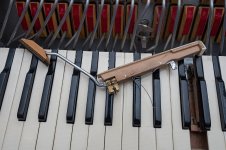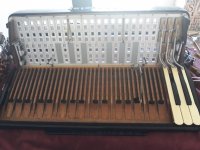FireSpirit
Member
Hello guys! I have an huge problem (i guess), some keys don't go up.
Last week I was playing normal and only the D of the first octave was like that, but it happens occasionally. I left the accordion in the case and went on a trip. Coming back from a trip, I went to play and those keys are like this. After that video, the A of the first octave was like this. I left the accordion out of the case and apparently it was back to normal, but it still happens a lot. What should it be? I theorized that it could be because of dirt or sweat (I sweat a lot).
Yesterday I realized that ... felt? (that fabric under the keys) is apparently loosening a lot, it even looks like "it's coming out".
What can it be?
Last week I was playing normal and only the D of the first octave was like that, but it happens occasionally. I left the accordion in the case and went on a trip. Coming back from a trip, I went to play and those keys are like this. After that video, the A of the first octave was like this. I left the accordion out of the case and apparently it was back to normal, but it still happens a lot. What should it be? I theorized that it could be because of dirt or sweat (I sweat a lot).
Yesterday I realized that ... felt? (that fabric under the keys) is apparently loosening a lot, it even looks like "it's coming out".
What can it be?



